*This article may contain product links which pay me a small commission if you make a purchase. Learn more.
Do you have experience, knowledge and wit to share with the universe? If so, give it a shot and start a podcast! Once up and running, a podcast is a low-cost way to give back to your industry, establish yourself as an expert, and have fun behind the mic.
In this article, I’m going to share the things I’ve learned over the years as the host and co-host of seven podcasts. You’ll learn everything you need to get started, what to avoid and what to definitely put a little extra time and effort into.
How to Start a Podcast
We’ll cover five sections in this article today, each one equally important:
- Your Niche, Audience & Goals
- Cover Image, Logo & Branding
- Equipment & Software & Cost
- Hosting & Getting Your Podcast on the Internet
- How to Get Others to Listen
I’m going to be really thorough on items 1, 2 & 4 and cut to specifics fast on items 3 & 4, so read as much or as little as you’d like!
#1. Your Niche, Audience & Goals
First, let me explain that my podcasts have two very different goals. As of 2020, I host or co-host five podcasts:
- Dear Baseball Gods
- Good Advice for Softball Families
- The Walk Up Song
- The Uptime Wind Energy Podcast
- The Struck Aerospace Engineering Podcast
Dear Baseball Gods,

This is my personal podcast, on which I tell stories from my baseball career, help educate players and parents on things they need to do to develop into good ballplayers, help teach amateur coaches, and interview guests who I ask to share their stories of how they made it into the coaching or pro baseball world.
If you’ve listened to mine, you’ll see that it has evolved in phases:
- Lots of stories and interviews with players who shared their own stories.
- Monologues from me more on the coaching side (I ran out of stories, kind of)
- Interviews with coaches, scouts and pro players (it’s hard to just talk solo for an hour, so I had to make a change).
With me, I produce LOTS of different content, some as a consultant for a lightning company. So now–as of the writing of this article–doing interviews only with interesting guests in high-up places of the baseball world makes the most sense as a compliment to the other forms of content I create (articles, pitching videos, a VLOG of stories on YouTube, my books.
I didn’t press to stick with one thing or another, and I really just learned as I went and tried to figure out “what my podcast was.” I think now–two years later–it’s third evolution fits well within the whole scope of what I do. The earlier topics I covered in the podcast are now better suited for video, I’ve come to learn.
So, don’t be afraid to dive in and just get going–it’ll evolve and that’s okay.
Twinsies
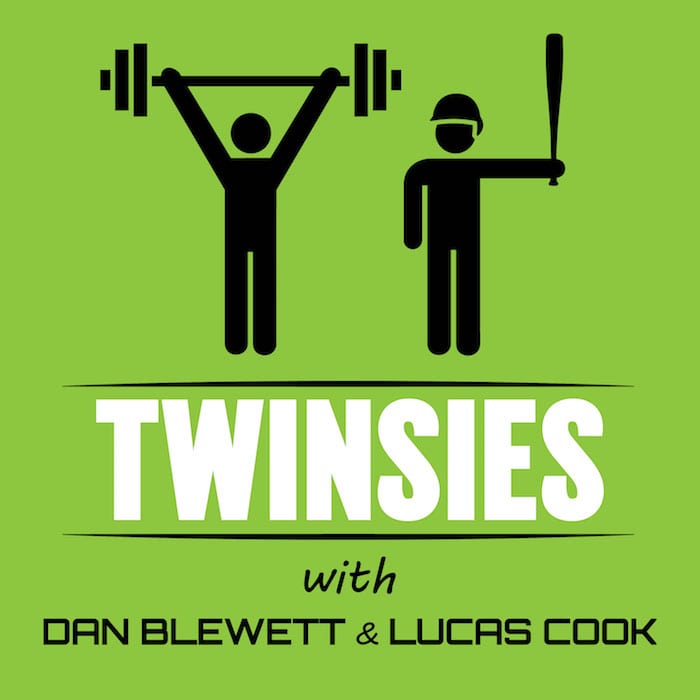
Twinsies is a podcast that I do with my business partner, Lucas Cook. We started this a few years ago as a way to share our knowledge and give more of ourselves to our clients.
We’re often very busy and don’t have much time to share much about who we are, nor do we have time to expound on common questions that parents ask us.
So we began podcasting to provide more guidance to our clients and potential clients.
Goals
You won’t make money on a podcast for a long time (or ever) unless you already have a large following. So, any goals you have should be centered around helping others and providing good content they enjoy and relate to.
If you’re a coach or an expert and you want to teach others, your initial goal should be to help people solve some sort of problem in each episode and/or gain a new understanding of something.
Typically, giving actionable things are better than just blurting out everything you know. But videos and how-to articles are better venues for actionable things, so I think the podcast world is a good place to really talk at length about things you know and want to teach.
But, in the end, give people a new perspective on something or a new idea of how to tackle a problem. This will win people over.
And, make it fun. Boring is boring so don’t be boring.
DO THIS👇
Narrowly define who you’re speaking to. You can’t speak to everyone, so finding some kind of niche is important. Identify your audience member and create your podcast for one person who is a good representative of your target audience as a whole.
Often, I literally think of ONE person who I’m talking to, whether it’s an article or video or whatever.
There’s a kid I used to work with who moved away to Arizona. He’s 16 now, but I worked with him when he was 14, so he’s sort of always that age to me in my head. He’s a good high school pitcher, a bit of a goofball, and someone who often sends me messages and asks for guidance. Many times I make videos and tell myself I’m filming it for him specifically.
It helps because talking as if my camera is a 14 year old helps me simplify my message and tailor it for my audience, of which he is a good representation.
#2. Cover Image, Logos and Branding

I’m a design snob and a professionalism snob.
I’ve built I think nine websites to this point in my life (I have no coding skills, but I’m good at googling things and learning software), and I believe the image we put forth sets the tone for how people view us.
So basically, I’ll tell you right now that if you logo looks like you made it in 15 minutes with popular fonts from the 1960s, I’m not going to listen to your podcast.
Content matters most, but people need to give you a chance first. Skimping on branding is like showing up to a job interview in sweatpants…
WHAT TO DO: Logo & Cover
- Hire Someone to Design it
- Chances are, you know someone who majored in graphic design in college. Graphic designers often compete in a tough job market (I know many who are underpaid), so lots will freelance and make you a logo and cover image for perhaps a few hundred bucks. If you don’t know a graphic designer, I know a few. Ask around.
- Or, you can go to Fiverr.com and look for a freelancer. There are many good freelancers there who are reasonably priced.
- Design it Yourself
- Look at other popular podcasts and use them as a guide for what seems to be the trend.
- Use The Noun Project or another website and grab an icon that can represent your podcast.
- Go to Canva.com and create a 1000×1000 pixel canvas (Canva is free), add a background color, your chosen icon, some modern-looking text (keyword: modern), then export. Again, google this if you’re unfamiliar with Canva.
- Then, ASK PEOPLE IF IT’S GOOD! Don’t ask people who love you. Get honest feedback. Email it to me if you want. It needs to be good enough where no one will write you off because your branding looks like it was made in a middle school tech class.
Below is an example of simple cover art I made for one of my online courses. It looks professional, clean and simple. It conveys the product well-enough and cost me basically zero dollars. It’s certainly not complex, but it’s good.
The logos of my two podcasts above, however, were designed by my business partner, who is basically a professional graphic designer.
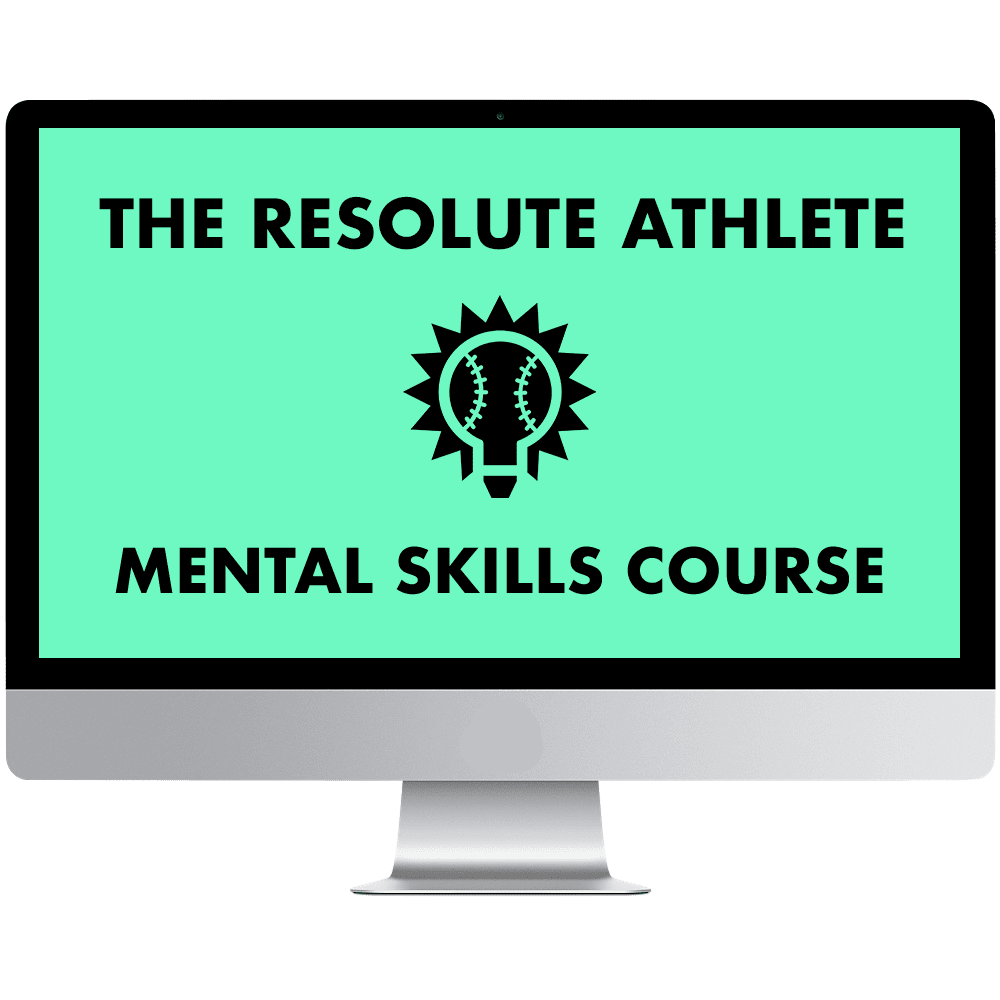
In summary, make it good enough for people to think you’re a serious professional.
Title & Social Media Availability
You should spend some time doing your due diligence on a title. Here’s an example: There is a second podcast called Twinsies.
We had the name first, and bought the domain name www.twinsiespodcast.com. But another pair of guys started their own podcast called Twinsies this past year, and I’m not sure why. They didn’t care–I suppose–the google serves us as the result when people search the title. It doesn’t matter much to us, but it’s probably hurting them to some degree if they want to grow it big.
DO THIS👇
- Search ALL social media platforms for your podcast title, and secure those @handles so if you DO want to market your podcast via social media through it’s own account, you can easily do so with consistent branding.
- Secure the simplest possible URL domain name with your podcast’s title. We could have chosen www.twinsies.com but twinsiespodcast.com made the most sense, as anyone searching it would search “Twinsies Podcast” anyway.
- Even if you don’t intend on having a website to host your podcast, you should secure the domain name. It’s $20 per year to keep ownership of the domain, so don’t skimp on it…and here’s why…
Your podcast might take off! Or, it might spin off into a YouTube channel or Book, or who knows…in which case you’ll want to have the branding secured.
For example, I own www.dearbaseballgods.com. I may use it someday or I may not. But it’s mine when and if I want to. For right now, it just redirects to DanBlewett.com.
Lastly, look at what other podcasts do. Do they have a website? Their own separate Twitter account? IG? FB? You don’t have to do all of it, but the more social media marketing you do with consistent branding, the more it will grow.
#3. Equipment & Software
This is a big one, and here’s what I’ll say:
Buy equipment that’s a little bit better than you’re inclined to buy. It will perform better, last longer, and give you a more professional sound with less hassle.
List of Equipment & Software You Need:
- Audio Recorder (best) or Laptop [you’ll record your audio into this]
- Microphones – one for each guest and host
- Pop Filters for Microphones [foam things that prevent the big “Puh” sound when you use a P-word (called plosives)
- Cables – which types depends on your setup–XLR, USB, or XLR-to-USB or 3.5mm
- Mic Stands. You really don’t want to hold the mic for an hour.
- Memory Card for audio recorder. 32GB cards are only $12 these days.
- Hosting for the podcast ($20/mo usually, and software to edit it (free or not free options).
- Website Domain if desired, hosting if you actually want a website for the podcast.
- A Quiet Place to Record.
The last thing you want to do is buy something, then six months later replace it either because it breaks or it’s not producing the high-quality audio you thought it would.
Example: Our Equipment & Set Up
Please note: The follow product links are affiliate links, which means if you click on a product I’ll make a small commission on anything you buy from Amazon within a 24-hour period, at no cost to you. It helps me keep producing free content, so I appreciate the support.
Okay, so here’s what we broadcast with:
1. Audio Recorder: Zoom H4N ($219 new, used for $120-$150)
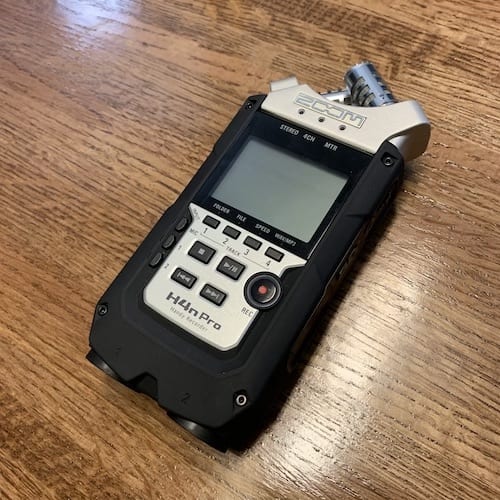
Why We Use This:
This model allows two XLR-input microphones (XLR inputs produce better sound than USB inputs, though both are good). It also allows two additional microphone channels via a 3.5mm audio adaptor if we have additional guests, so it works well for up to four people.
Audio recorders are relatively easy to use and a very safe way of recording your audio. They can be run on batteries or a wall-outlet and basically never fail. They’re portable and you can monitor the sound as you go.
Do You Need an Audio Recorder?
It depends. If you’re a one man show, you can easily record directly into your computer with a USB microphone.
But if you have two or more people plus additional guests…a recorder is a must. And, buying a decent one–even used, which I often do–will last you a long time.
2. Microphone(s)
My Recommendations are the following, because I own two different types did a lot of research:
Shure SM58 ($99) – I own one of these, it’s my favorite mic.
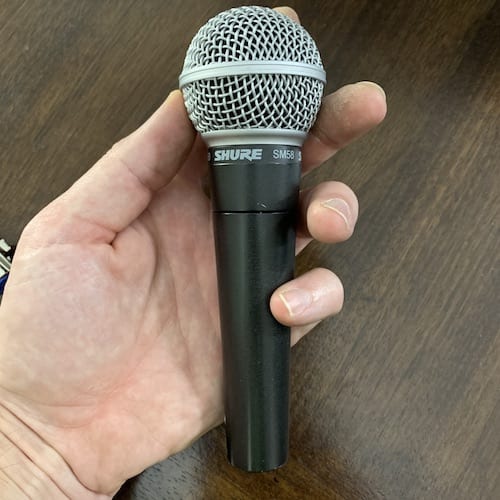
The SM58 is the mic most artists sing into on stage–celebrities are belting out their vocals into the SM58 in most instances. It’s a great mic, super durable and every part is replaceable. BUT…
It’s XLR-only, which means you’d need an audio interface ($30 and up) if you want to use it as a USB mic and plug into your computer. If you’re going to plug it into an audio recorder’s XLR input then you’re ready to go out of the box.
Note: I bought my SM58 used for $45 on Mercari.com. Don’t be afraid of used equipment…most people take good care of their electronics.
Audio Technica ATR2100 ($67) – We own two of these, they are versatile and very good.
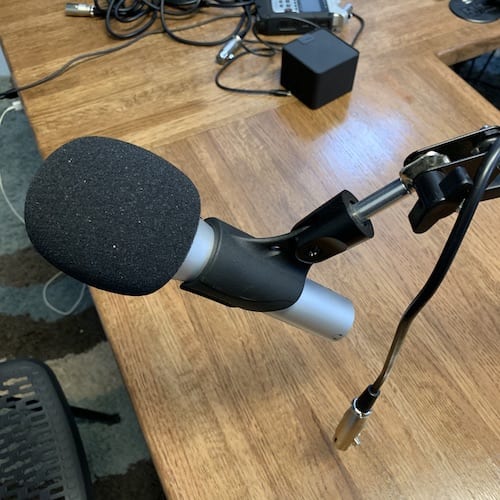
These are probably what you should buy starting out. They are USB or XLR, so you can use them any way you want. They’re portable–handheld or mounted in a stand or boom arm if you want. All-around, they’re the easiest to use without additional equipment like an audio interface (in the case of the SM58).
We bought these new, and they came with a Pop filter and stand each (though the stands weren’t great).
Blue Yeti ($110 on average)
I do NOT own a Blue Yeti, so be sure to do your own research. But, they are very well-reviewed and are said to be durable, good-sounding and versatile USB Mics. They are bigger than you’d think and are kind of heavy (I’ve fondled them in person), but sit well on a table or desk and can be mounted in a stand.
Pop Filters
Your mic may come with one, and yes–you do need one. They come in two forms:
- The fuzzy black foam ball at the end
- The circular screen placed held in place a few inches from the mic, attached to a stand.
They both work the same but the foam ball is cheaper and easier, and is still there if you go handheld. Many mics come with them so read what’s in the box.
Microphone Stands
We have two different kinds: Boom arms that clamp to a table, and free-standing ones. Personally I prefer the boom arm because I can use it in any situation–sitting, standing, etc.
But, both work just the same and make life way easier. $12-20 per stand is about what you’ll spend, and make sure the stand is compatible with your mic. They’ll usually just thread onto the mic holder that comes with your microphone.
Boom-Arm Type Stand ($13)
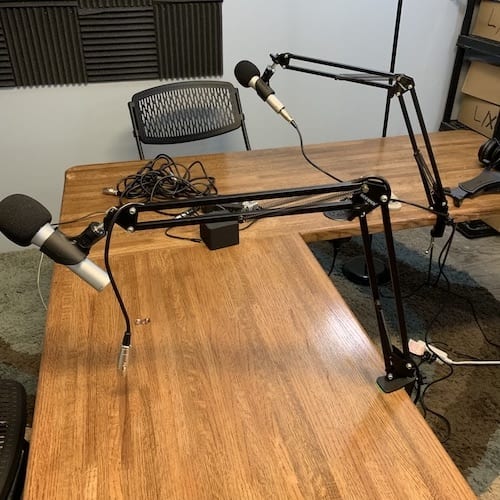
Free-Standing Type Stand ($19)
Audio Editing Software
I have experience with two types, which are both the industry standards.
NOT FREE – Adobe Audition
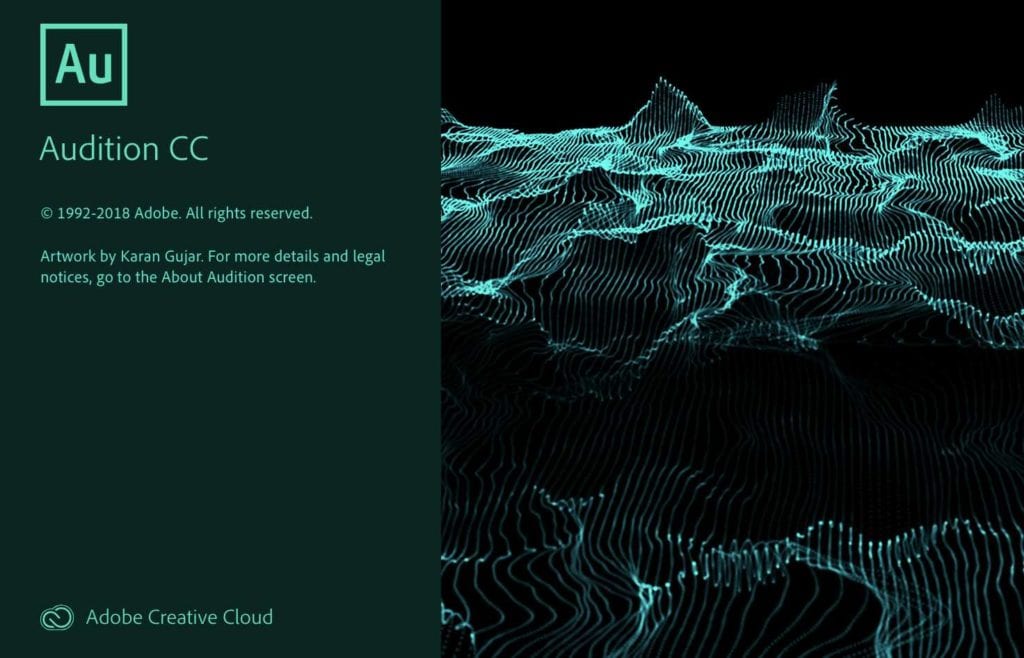
There’s probably not a good reason for you to start with Adobe Audition. I use it because we already pay for the whole suite ($69/mo) of Adobe software that I use to edit videos, photos, documents, PDFs, etc. It made sense for me as a piece of a package I already owned.
However, Audacity is free and very good.
FREE – Audacity

Audacity, though, is free and it was the first audio editing software I used. It worked well, was relatively easy to learn and for the basics of podcasting it’s a breeze. It was a bit complex to figure out how to get the completed files into .MP3 format, though, which is a requirement.
After you export a file, run it through iTunes then convert it to an MP3 using iTunes. This article will explain how.
Podcast Hosting. (STAY WITH ME ON THIS ONE!)
You need hosting to put your podcast into podcastland. Hosting is a server to hold your audio files so they load faster on your website, or so they have a place to exist in podcastland if you don’t have a website.
So you need to pick a host. There are three major ones.
Blubrry (I use this one)
I use Blubrry because as the owner of a website created with WordPress backend software, it integrates the easiest. If you’re not using WordPress on your website, any of the three options are probably equally good.
Blubrry also has an excellent podcasting support manual, where I learned most of this stuff. You can find it here. HIGHLY recommend reading it. And if you end up choosing them as your provider, you can get your first month free by using the code DearBaseballGods at check out.
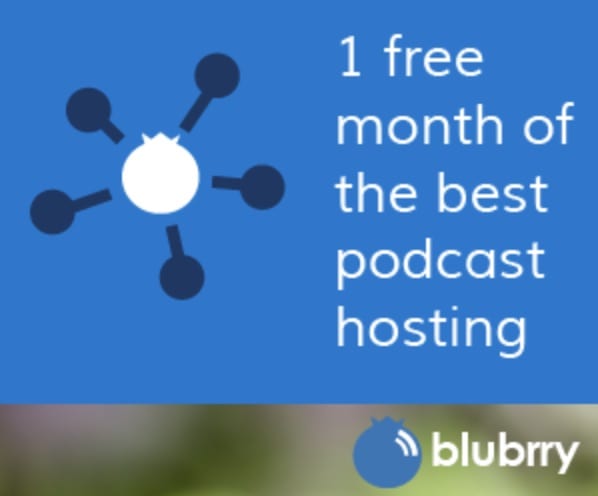
Soundcloud
Soundcloud is an awesome platform for independent music and audio creators. I like it a lot in general but I have no good reasons to choose it over others.
Libsyn
Libsyn’s website is awkward and ugly, which is one reason I shy-ed away from it. But many big-name podcasters use it.
Which Plan To Buy
Basically, all the hosting plans are very similar no matter the company, and you need to choose one that fits the size of your podcast.
Basically, your podcast will be 50-80mb per 60-minutes. So I personally have the 250mb plan ($20 per month) from Blubrry because I typically use right at 250mb or so each month, creating 4 episodes per month at 45-60 minutes each.
How To Get Your Show on iTunes, Stitcher, Spotify, Etc.
All of these platforms will create a “feed,” which is just an updating place where your podcast resides. iTunes, for example, scans every feed that is submitted to it every few hours. When you release a new episode (and you’ve submitted your show to iTunes), iTunes will see on your feed that a new episode is present, then grab it and pull it onto iTunes. That’s how it all works.
So with ANY of the hosting providers, you can submit your podcast to as many platforms as you want at no cost.
Again, my podcast is hosted with Blubrry but has been submitted to–and thus appears on–the following:
- iTunes
- Spotify
- Stitcher
- Google Play
- Player FM
- My website
- YouTube (I have to convert my audio into video, so this is a manual step I choose to undertake)
For information on how to submit your podcast, you’ll want to go through documentation from the hosting provider you choose.
Why Submit on So Many Platforms?
First, because iTunes–for example–is basically just a Mac platform. If you don’t have an iPhone, you probably don’t listen to podcasts on iTunes.
Spotify is a popular music player, and thus a convenient place to have your podcast for the millions of Spotify users.
Stitcher caters a lot to Android users, as does Google Play.
And, you never know who prefers to listen where, so you want to be anywhere people are listening to maximize your reach.
#5. How to Get People to Listen
This is important, so you want to plan out your overall strategy.
People will NOT know about your podcast unless you tell them. The best way to tell them is via:
- An email list
- Snapchat
- YouTube
Instagram is probably the worst unless you have 10,000 followers or more, because if you don’t, the only way to link to it is through your bio. It’s not ideal.
You’re fine choosing the one platform you prefer, but remember that people spend unique amounts of time on different platforms.
Personally, I spend zero time on Facebook, I get news and articles from Twitter, zero time on LinkedIn, some time on Instagram, some time on Snapchat, a lot on YouTube and I email my email list 1-2x per week.
My strategy is to email my email subscribers with every new episode with links to all platforms (including YouTube), post it on facebook once, twitter a few times, Instagram story once, and LinkedIn once if I remember LinkedIn exists. Is that perfect? Probably not, but it gets the word out.
Hopefully This Helped. Getting started with Podcasting is…Confusing
The whole thing is honestly way more complex than it needs to be to get started, have your podcast hosted, appear on all the platforms, etc. etc.
But, once you get all of that set up and get comfortable with your equipment and basic editing, it’s pretty easy. Like anything, there’s a learning curve but diving in is the way to go.
Have a question or comment? Leave one below.
And, if you want to learn more about what I create, see how I do things, and stay in touch, subscribe to my email list here.
